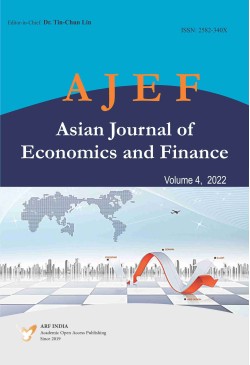
Asian Journal of Economics and Finance
Frequency :Quarterly
ISSN :2582-340X
Peer Reviewed Journal
The main purpose of this study is to explore the relationship between diversification strategy and the cost of capital, and provide Taiwanese companies with advices while doing the diversification decision making. We obtain data from Taiwan Economic Journal (TEJ) database during the period of 2004 to 2013. The total sample is 4,048 firm year observations. We employ multivariate regression analysis to analyze the degree of diversification strategy’s impact on cost of equity capital, cost of debt capital, and the weighted average cost of capital. The results show that the degree of diversification cannot affect corporate cost of capital, implying that stakeholders are not convinced by the risk reduction through firms’ diversification strategies.
Key words: Diversification; Cost of Equity Capital; Cost of Debt Capital; Weighted Average Cost of Capital.
Modigliani and Miller propositions form the theoretical foundation of corporate finance and asset valuation. They exert tremendous influence on financial research and financial practices. Yet Modigliani and Miller propositions were derived from very restrictive assumption of cash flows.We prove that their derivations not valid for more general patterns of cash flows. Modigliani and Miller propositions, when applied to asset valuation, can generate systematic and sometimes substantial misevaluation. Specifically, using WACC to value growth firms will systematically overestimate the value of these firms.
Keywords: WACC, Modigliani and Miller propositions, asset valuation
JEL classifications: G12, G30, G32
We examine the impact of remittances on economic growth using panel data (1975-2014) for 18 countries in Asia and Sub-Saharan Africa (SSA) that are similar in size and development level. We allow for heterogeneous production functions across countries and calculate the average marginal effects of remittances using the panel dynamic ordinary least squares estimator. The estimation results show that remittances increase growth significantly, especially through investments in human capital. In addition we find that: (i) remittances have a modest impact on growth when controlling for physical and human capital channels through which remittances potentially affect output growth; (ii) when we do not control for human capital the effect is larger regardless of the sub-samples considered ? the elasticity of output with respect to remittances is 7.3 percent in the full sample, and 18.6 percent among Asian countries; (iii) remittances have a significant positive long-run effect on human capital formation regardless of the sub-samples considered but the effect on physical capital accumulation is significant only among middle income and Asian countries. The findings suggest that channeling the remittances towards investments in physical capital and adoption of new knowledge, skills and technology is crucial for high economic growth in low income countries.
Keywords: Economic growth; human capital; international remittances
JELCodes: C24, O15
Purpose This
paper aims to measure the degree of market power for Thai sugar exporters in Japan market. Methodology – This paper adopted nonlinear GMM to estimate the demand and supply equations. Findings – Thai sugar is not competitive in Japan market. Originality/Value – This paper followed Devadoss et al. (2013) which proved that only demand and supply equation are enough to enable identification process of conjectural elasticity and inverse market demand elasticity which discussed by Appelbaum (1982)
Keywords: Market Power, Sugar, Japan, nonlinear GMM.
This paper uses a panel of 818 Indian listed firms over the period 20122018 to study how the investmentcash flow sensitivity differs across firms facing different levels of internal and external financial constraints, firms with and without state ownership, and firms in different geographical locations. This paper results suggest that the firms facing lower internal constraints have higher investmentcash flow sensitivity, and firms facing higher external constraints have higher sensitivity. The dependency of investment on cash flow is weaker for state controlled firms, especially the large ones, than other firms. Firms in the eastern and central India are subject to significant and stronger financial constraints than firms in western India, which may be closely related to India’s regional development policy.
Keywords: Firms’ investment; Financial constraints; Errorcorrection model; India’s regional development policy.